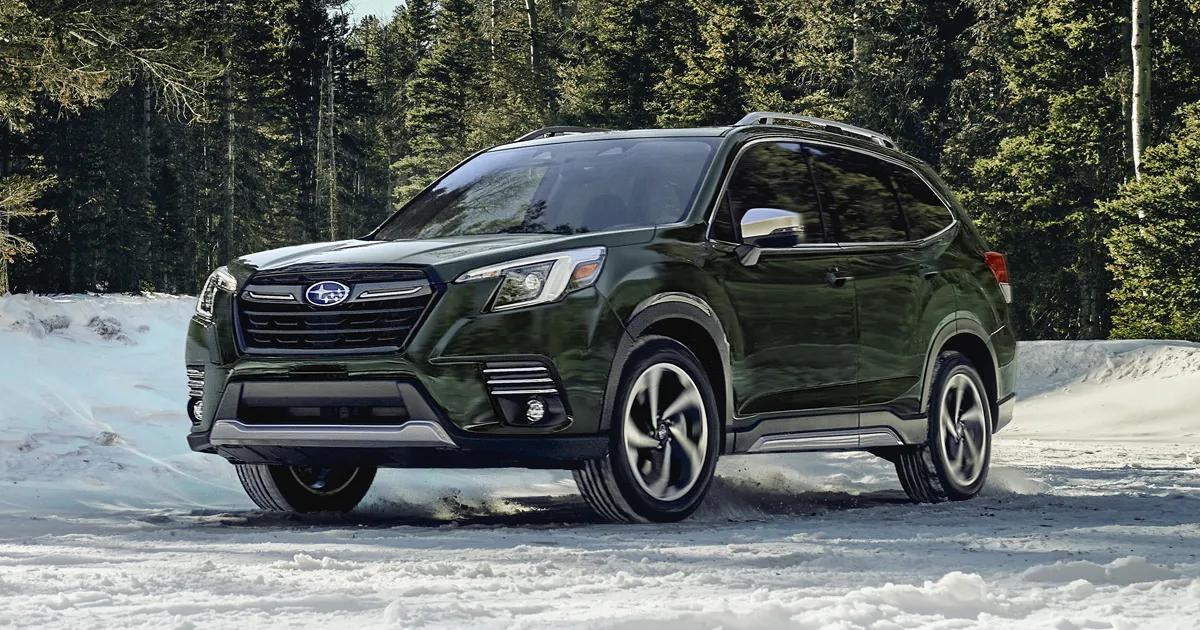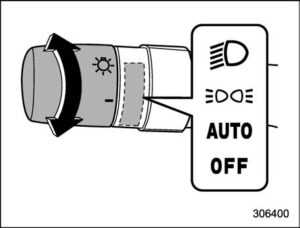Subaru Forester 2023 How to get the source code And Light control switch Base
In the constantly changing world of car tech, the 2023 Subaru Forester shows how committed the brand is to new ideas, safety, and the best possible driving experience. The Light Control Switch is a key part that shows how dedicated this company is. It is an important interface that makes it easy for drivers to change their vehicle’s lighting settings. This ergonomic switch, which fits perfectly into the Forester’s interior and shows how well Subaru pays attention to detail, makes it easy for drivers to adapt to different driving situations while putting safety first. The Light Control Switch is a flexible tool that makes driving more comfortable and improves visibility. It can be used to dim the dashboard lights for night driving or change how bright the lights inside the car are. To fully understand how important this feature is, you have to look into the complicated code that makes it work. This shows how good Subaru is at balancing cutting-edge technology with the needs of everyday driving.
2023 Subaru Forester Specs, Price, Features, Mileage (Brochure)
How to get the source code using the open-source
Free/Open Source Software Information This product contains Free/Open Source Software (FOSS). The license information and/or the source code of such FOSS can be found at the following URL. http://www.globaldenso.com/en/open-source/ivi/subaru/
Clock
For models with a SUBARU genuine navigation and/or audio system, the clock can be adjusted using either auto mode or manual mode.
- Auto mode: Automatic clock adjustment
- Manual mode: Manual clock adjustment
CAUTION
The clock in the multi-function display (color LCD) cannot be adjusted, if the SUBARU genuine navigation and/or audio system is removed.
Setting the clock manually
Type A multi-function display (black and white)
- Turn the ignition switch to “ON”.

- Press the button.
- Select “Settings”.
- Select “Vehicle”.
- Select “Time/Date” and then select “Manual”.
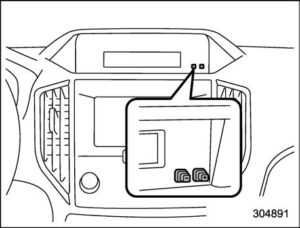
- Press the “+” button or the “−” button beside the clock.
Setting 12-hour or 24-hour display
The clock can be set to a 12-hour or 24-hour display. Perform the following procedure to switch the display format.
- Turn the ignition switch in the “LOCK”/ “OFF” position.
- Press and hold the “−” button located near the clock display for approximately 5 seconds. The clock display will then start to flash.
- While the clock display is flashing, press and hold the “+” button for approximately 2 seconds. The clock format will then change.
- The clock display will continue to flash for approximately 3 seconds to indicate that the clock display has been changed.
Type B multi-function display (color LCD)
- Turn the ignition switch to “ON”.
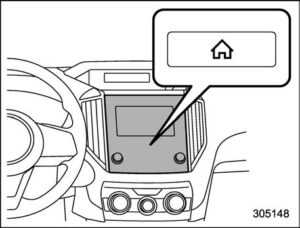
- Press the button.
- Select “Settings”.
- Select “Vehicle”.
- Select “Time/Date” and then select “Manual”.
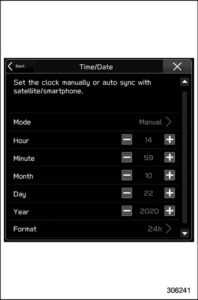
- Set each item’s plus and minus. Select to complete the clock setting.
- Select “Back” to return to the previous screen without saving settings.
NOTE
- Adjust the time, then select 12h display or 24h display from the format.
- The Birthday/Anniversary and maintenance reminder system functions are based on the time and date on the multi-function display (color LCD).
Setting the clock automatically
- Turn the ignition switch to “ON”.

- Press the button.
- Select “Settings”.
- Select “Vehicle”.
- Select “Time/Date” and then select “Auto”.
- Press the button again to complete the setting.
Models with navigation system
The clock will be set automatically where a GPS signal is available.
Models without navigation system
The clock will be set and adjusted automatically when a smartphone is connected via Bluetooth® for transferring phonebook data.
- Register the smartphone to the audio system. For details, refer to “Bluetooth SETTINGS” in the supplemental Owner’s Manual for the audio/navigation system.
Transfer phonebook data to the system. For details, refer to “Bluetooth SETTINGS” in the supplemental Owner’s Manual for the audio/navigation system. The clock will be adjusted automatically.
NOTE
Depending on the model of the smartphone, the settings of the connected smartphone may need to be changed.(ex: For iOS or other models, notification settings may need to be activated.) For details, check the instructions on connecting smartphones.
Regulatory information
Bluetooth
The Bluetooth® word mark and logos are registered trademarks owned by Bluetooth SIG, Inc.
Light control switch
Precautions and tips
- Use of any lights for a long period of time, while the engine is not running, can cause the battery to discharge.
- Before leaving the vehicle, make sure that the lights are turned off. If the vehicle is left unattended for a long time with the lights illuminated, the battery may be discharged.
NOTE
- Even if the key is removed from the ignition switch, the lights can be illuminated by operating the light control switch from the “ ” (off) position to the “ ” or “ ” position (models without “keyless access with the push-button system”).
- Even if the push-button ignition switch is turned off, the lights can be illuminated by operating the light control switch from the “ ” (off) position to the “ ” or “ ” position (models with “keyless access with push-button start system”).
- If the driver’s door is opened while the lights are illuminated and the key is removed from the ignition switch, the chirp sound will inform the driver that the lights are illuminated.
Headlights
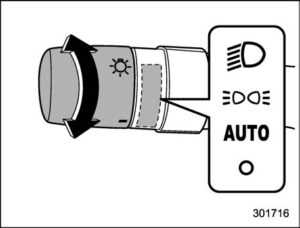
Except for Canada models
For Canada models
To turn on the headlights, turn the knob on the end of the turn signal lever.
position:
Instrument panel illumination, headlights, parking lights, front-side marker lights, rear-side marker lights, tail lights and license plate lights are on.
position:
Instrument panel illumination, parking lights, front-side marker lights, rear-side marker lights, tail lights, and license plate lights are on.
position:
- Auto on/off headlights
When the ignition switch is in the “ON” position, the instrument panel illumination, headlights, parking lights, front side marker lights, rear side marker lights, tail lights and license plate lights are automatically on or off depending on the level of the ambient light.
NOTE
- The sensitivity of the auto on/off headlights can be changed by a SUBARU dealer. Consult your SUBARU dealer for details. Also, the setting can be changed using the display.
- If the light control switch is in the “AUTO” position and the headlights do not turn on when it becomes dark outside, turn the light switch to the “ ” position. If this happens, have your vehicle inspected by your SUBARU dealer as soon as possible.
position (except for Canada mod-els):
The headlights are all off. Only when the following conditions are fulfilled, are instrument panel illumination, headlights, parking lights, front side marker lights, rear side marker lights, tail lights, and license plate lights automatically on or off depending on the level of the ambient light. - The engine is running.
- The parking brake is fully released.
- The select lever is in a position other than the “P” position.
“OFF” position (for Canada models):
The headlights are all off *1*2.- When the light switch is switched to the “OFF” position while the vehicle is stopped, the lights turn off. Then the light switch will automatically return to the “AUTO” position.
- The headlights will automatically change to AUTO mode when the following conditions are met:
- The engine is running.
- The parking brake is fully released.
- The select lever is in a position other than the “P” position.
- Auto-on/off wiper-linked headlights While the light control switch is in the “AUTO” position, the headlights will automatically turn on when the windshield wipers operate several times. The headlights will automatically turn off when the wipers stop.
NOTE
The ON/OFF setting of this function can be changed by a SUBARU dealer. Consult your SUBARU dealer for details.
Welcome lighting function
The welcome lighting function turns on the low beam headlight for smooth approaching to or exiting from the vehicle at night or in a dark place. The function is activated while all of the following conditions are met.
- The light control switch is in the “AUTO” position.
- It is dark enough to turn on the auto on/ off headlights.
NOTE
If the engine is turned off after turning off the light switch, the welcome lighting function may not operate (Canada models).
When approaching:
While the welcome lighting function is activated, the low beam headlights, instrument panel illumination, parking lights, front side marker lights, rear side marker lights, tail lights, and license plate lights will automatically illuminate when unlocking the doors and the rear gate by using the remote keyless entry system. The lights will remain illuminated for 30 seconds*1 and then turn off. However, if any of the following operations is done, the lights will turn off.
- The doors are locked.
- The light control switch is turned to a position other than “AUTO”.
- The ignition switch is turned to the “ON” position.
When exiting:
While the welcome lighting function is activated, the low beam headlights, instrument panel illumination, parking lights, front side marker lights, rear side marker lights, tail lights, and license plate lights will remain illuminated even when either of the following operations is done.
- The push-button ignition switch is turned to the “OFF” status (models with “keyless access with push-button start system”).
- The key is pulled out from the ignition switch (models without “keyless access with push-button start system”).
The lights will turn off under any of the following conditions.
- 3 minutes have passed since the lights were illuminated by the welcome lighting function.
- 30 seconds have passed since the door was opened and closed.*1
- The light control switch is turned to a position other than “AUTO”.
- The locking procedure is performed twice. When performing the unlocking procedure after performing the locking procedure, perform the locking proce-dure twice again.
- The setting for the period of time in which the low beam headlights remain on by the welcome lighting function can be changed by a SUBARU dealer. Contact your SUBARU dealer for details.
Sensor for the auto on/off headlights
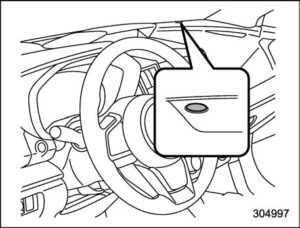
The sensor is as shown in the illustration.
How to get the source code using the open1 If any object is placed on or near the sensor, the sensor may not detect the level of the ambient light correctly and the auto on/off headlights may not operate properly.
High/low beam change (dimmer)
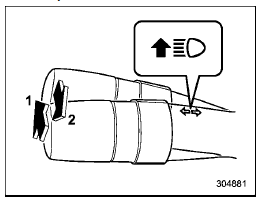
- High beam
- Low beam
When the headlights are on a high beam, the high beam indicator light “ ” on the combination meter is also on.
Headlight flasher
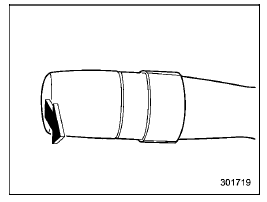
CAUTION
Do not hold the lever in the flashing position for more than just a few seconds. To flash the headlights, pull the lever toward you and then release it. The high beam will stay on for as long as you hold the lever. When the headlights are on a high beam, the high beam indicator light “ ” on the combination meter also illuminates.
High beam assist function
NOTE
- The high beam assist function utilizes the stereo camera installed at the position of the upper side of the windshield.
- For details on how to handle the stereo camera, refer to the Owner’s Manual Supplement for the EyeSight system.
The high beam assist function automatically changes the headlight from high beam to low beam (or vice versa). When all of the following conditions are met, the headlight will change to a high beam.
- When the vehicle speed increases to or above 20 mph (32 km/h).
- There is no preceding or oncoming vehicle.
- The forward area of the vehicle is dark. The road does not have a sharp curve.
When any of the following conditions are met, the headlight will change to a low beam. When the vehicle speed decreases to or below 10 mph (16 km/h).
- When the forward area of the vehicle is bright.
- When there is a preceding or oncoming vehicle.
- When the EyeSight system is malfunctioning or is temporarily stopped.
NOTE
- Do not overestimate the capacity of the high beam assist function. The driver always has the responsibility to understand the surrounding situation, to drive safely, and to change the headlight mode manually if necessary.
- The factory setting (default setting) for this function is set as “operational”. This setting can be changed to OFF (non-operation) at SUBARU dealers. For more details, contact a SUBARU dealer.
How to use the high beam assist function
The high beam assist function will be activated when all the following conditions are met.
- The light control switch is in the “AUTO” position and the low-beam headlights are on automatically.
- The turn signal lever is pushed forward.
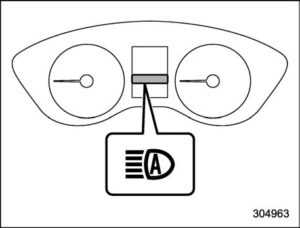
High beam assist indicator light
When the high beam assist function is activated, the high beam assist indicator light on the combination meter will illuminate.
NOTE
If the high beam assist function is malfunctioning or is temporarily stopped, the headlight will be fixed at the low beam.
How to temporarily lower the sensitivity of the high beam assist function
The sensitivity of the high beam assist function can be lowered by performing the following operations.
- Before turning the ignition switch to the “ON” position, set the light control switch to the “AUTO” position and push the signal lever forward (high beam position).
- Turn the ignition switch to the “ON” position and within approximately 15 seconds, press the “ / ” (following distance setting) switch more than 10 times consecutively.
When the sensitivity of the high beam assist function is lowered, the high beam assist indicator light “ ” on the combination meter will flash.
NOTE
- The sensitivity of the high beam assist function cannot be lowered in the following conditions.
- The cruise control or Adaptive Cruise Control indicator is illuminated.
- The EyeSight warning indicator (yellow) is illuminated.
- The sensitivity of the high beam assist function returns to a normal level the next time the ignition switch is turned to the “LOCK”/ “OFF” position and the engine is restarted.
How to change the headlight mode manually
Change to the low beam:
When you return the turn signal lever to the center position, the high beam assist function will turn off and the high beam assist indicator light will turn off.
Change to the high beam:
When you turn the light control switch to the “ ” position, the headlight mode will be changed to the high beam. At this time, the high beam assist function will turn off, the high beam assist indicator light will turn off and the high beam indicator light will turn on.
NOTE
- After manually changing the headlight mode to the high beam, if you turn on the high beam assist function, return the light control switch to the “AUTO” position.
- When manually changing the headlight mode to the high beam, if you turn the light control switch to the “ ” position, the instrument panel illumination, parking lights, front side marker lights, rear side marker lights, tail lights and license plate lights will be on.
Tips for the high beam assist system
- The high beam assist function recognizes the conditions surrounding the vehicle based on the brightness of illumination ahead of your vehicle, etc. Therefore, the headlight mode may switch in some situations that do not match to the driver’s sense.
- A bicycle or cargo cycle may not be detected.
- Under the following situations, the brightness of ambient illumination may not be detected correctly and the high beam assist function may not work properly. As a result, the glare of the high beam may disturb the oncoming vehicle or vehicle ahead. Also, the low beam mode may continue although there are no oncoming vehicles and vehicles ahead. In the such cases, change the headlight mode manually.
- In bad weather (fog, snow, sand storm, heavy rain, etc.).
- When the windshield glass is dirty or fogged.
- When the windshield is cracked or damaged.
- When the stereo camera is de-formed or the stereo camera lenses are dirty.
- If there are lights similar to the headlights or the tail lights in the surrounding area.
- When an oncoming vehicle or vehicle ahead is driven without its headlights and tail lights on.
- If the headlights of an oncoming vehicle or the tail lights of a vehicle ahead are dirty or discolored, or if the light beams are not aimed correctly.
- When a rapid change of brightness continues while driving.
- When driving on a road with many ups and downs or uneven surfaces.
- When driving on a road with many curves.
- When there are some objects that reflect light strongly, such as a road sign or a mirror in vehicle ahead.
- When the rear part of the vehicle ahead, such as a container, reflects light strongly.
When the headlights of your vehicle are damaged or dirty. - When your vehicle is tilted, such as in case the vehicle has a flat tire or is being towed.
- Immediately after the engine has started.
- In the following conditions, the head-light mode will not be automatically changed from the high beam to the low beam.
- When your vehicle passes an oncoming vehicle suddenly in a blind curve.
- When another vehicle passes in front of your vehicle.
- When an oncoming vehicle or vehicle ahead comes in and out of view because of continuous curves, median strips, roadside trees, etc.
- If the stereo camera detects the light of the front fog lights of an oncoming vehicle, the headlight mode may change from the high beam to the low beam automatically.
- The headlight mode may change from the high beam to the low beam, or the low beam mode may continue, when affected by a street light, traffic signal, illumination of an advertisement board, or a reflective object such as a road sign and signboard.
- The timing of the change of headlight mode may differ due to the following factors.
- Color or brightness of the headlights of an oncoming vehicle or the tail lights of a vehicle ahead.
- The headlights of the oncoming vehicle or the tail lights of the vehicle ahead are covered with mud, snow, etc.
- Movement and direction of an on-coming vehicle or a vehicle ahead.
- When the headlights of an oncoming vehicle or the tail lights of a vehicle ahead illuminate on only one side.
- When the oncoming vehicle or vehicle ahead is a motorcycle.
- Conditions of a road (slope, curve, road surface, etc.).
- Number of passengers and weight of loaded cargo.
- Limitation of the detection ability of the stereo camera.
- If the EyeSight traffic lane customization is not set to the actual flow of traffic.
Daytime running light system
WARNING
When the daytime running lights are illuminated, the tail lights do not illuminate. When it becomes dark outside, turn the light switch to the “ ” position to illuminate the headlights and tail lights. This will improve visibility and allow other drivers to see your vehicle more easily.
The daytime running lights will automatically illuminate when the following conditions are fulfilled.
- The engine is running.
- The parking brake is fully released.
- The light control switch is in “AUTO” (if equipped), “ ” or “ ” (except for Canada models).
- The light control switch is in “AUTO”, “ ” or “OFF” (for Canada models).
- The select lever is in a position other than the “P” position.
NOTE
When the light switch is in the “ ” position, the instrument panel illumination, front side marker lights, tail lights and license plate lights are also illuminated.
FAQ
The 2023 Subaru Forester is a compact SUV that blends functionality, safety, and performance, catering to a wide range of drivers.
The Light Control Switch is a feature in the 2023 Forester that allows drivers to adjust the illumination settings of the vehicle’s interior and exterior lights.
The Light Control Switch enables drivers to control various lighting aspects, such as dashboard lights, interior ambient lighting, and exterior lights, based on their preferences and driving conditions.
The Light Control Switch enhances driving comfort and safety by allowing drivers to tailor the lighting to different situations, thereby improving visibility and minimizing distractions.
Yes, you can adjust the brightness of the dashboard lights using the Light Control Switch, making nighttime driving more comfortable and less tiring.
Yes, the Light Control Switch offers customization options, letting you adjust the lighting intensity to your liking.
By allowing drivers to optimize lighting conditions, the Light Control Switch enhances overall visibility, reducing the risk of accidents and ensuring safer driving.
Absolutely, the Light Control Switch enables you to adjust the intensity of ambient cabin lighting to create a pleasant atmosphere inside the vehicle.
Accessing the source code for the Light Control Switch might not be publicly available, as it’s proprietary information owned by Subaru.
Automakers often consider the source code for their vehicle features to be proprietary, protecting their technology and intellectual property.
While accessing the source code directly might not be possible, you can explore Subaru’s official documentation, developer resources, or APIs for insights into the switch’s functionalities.
Check Subaru’s official developer resources, technical documentation, or community forums, which might offer information on interfacing with vehicle systems.
Modifying the behavior of the Light Control Switch could have implications on safety and vehicle warranty. Always consult with professionals before attempting any modifications.
Subaru may release software updates to enhance the functionality of the Light Control Switch, so it’s advisable to stay updated through official channels.
Subaru likely employs rigorous testing and quality assurance processes to ensure the reliability, safety, and performance of the Light Control Switch’s source code before implementing it in vehicles.
Useful Link
View Full User Guide: Subaru Forester 2023 Base User Guide
Subaru Forester 2023 Driver Monitoring System Base User Guide

